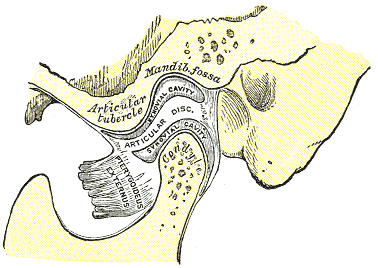
Anatomy
Head and Neck
Retraction of the mandible is produced by all of the following muscles, EXCEPT for:
Answer:
Retraction of the mandible is carried out by the geniohyoid and digastric muscles and by the posterior and deep fibres of the temporalis and masseter muscles respectively. The lateral pterygoid acts to protract the mandible.Temporomandibular Joint
Anatomy / Head and Neck / Temporomandibular Joint
Last Updated: 5th October 2019
The temporomandibular joints allow opening and closing of the mouth and complex chewing and side-to-side movements of the lower jaw. Opening of the mouth involves both depression and protrusion of the mandible. Closing of the mouth involves elevation and retraction of the mandible.
Table: Overview of the Temporomandibular Joint
| Joint | Temporomandibular Joint (TMJ) |
|---|---|
| Articulations | Condylar head of mandible with articular fossa and articular tubercle of squamous part of temporal bone |
| Stabilising factors | Lateral ligament, sphenomandibular ligament, stylomandibular ligament |
| Movements | Elevation and depression, retraction and protraction, side to side movements |
Articulations
Each joint is synovial and formed between the condylar head of the mandible and the articular fossa and articular tubercle of the squamous part of the temporal bone.

Articulations of the Temporomandibular Joint. (Image by Henry Vandyke Carter [Public domain], via Wikimedia Commons)
Ligaments
The joint is stabilised by three extracapsular ligaments:
- the lateral (capsular) ligament extending from the articular tubercles of the temporal bone to the neck of the mandible
- the sphenomandibular ligament extending from the spine of the sphenoid bone at the base of the skull to the medial side of the ramus of the mandible
- the stylomandibular ligament extending from the styloid process of the temporal bone to the posterior margin of the mandible.
![Henry Vandyke Carter [Public domain], via Wikimedia Commons](https://mrcemsuccess.com/wp-content/uploads/2016/07/TMJ-ligaments.png)
Extracapsular Ligaments of the Temporomandibular Joint. (Image by Henry Vandyke Carter [Public domain], via Wikimedia Commons)
Movements
Table: Movements of the Temporomandibular Joint
| Joint Movement | Muscles Involved |
|---|---|
| Depression | Digastric, geniohyoid, mylohyoid, lateral pterygoid, (plus gravity) |
| Elevation | Temporalis, masseter, medial pterygoid |
| Protraction | Lateral pterygoid, medial pterygoid |
| Retraction | Geniohyoid, digastric, temporalis, masseter |
Movements of the mandible include depression, elevation, protrusion and retraction.
Movements of the mandible at the TMJ:
- Depression is generated by the digastric, geniohyoid, mylohyoid muscles on both sides, is normally assisted by gravity, and, because it involves forward movement of the head of the mandible onto the articular tubercle, the lateral pterygoid muscles are also involved.
- Elevation is a very powerful movement generated by the temporalis, masseter and medial pterygoid muscles.
- Protraction is mainly achieved by the lateral pterygoid, with some assistance by the medial pterygoid.
- Retraction is carried out by the geniohyoid and digastric muscles and by the posterior and deep fibres of the temporalis and masseter muscles respectively.
Clinical Implications
The TMJ is less stable when the mouth is open. Anterior dislocation of the TMJ can occur by yawning or taking a large bite. The head of the mandible slips out of the mandibular fossa and is pulled anteriorly. The patient is unable to close their mouth. Posterior dislocation is uncommon but may occur due to a blow to the face. If traumatic, the facial and auriculotemporal nerves may be affected due to their close proximity to the joint.
Report A Problem
Is there something wrong with this question? Let us know and we’ll fix it as soon as possible.
Loading Form...
- Biochemistry
- Blood Gases
- Haematology
| Biochemistry | Normal Value |
|---|---|
| Sodium | 135 – 145 mmol/l |
| Potassium | 3.0 – 4.5 mmol/l |
| Urea | 2.5 – 7.5 mmol/l |
| Glucose | 3.5 – 5.0 mmol/l |
| Creatinine | 35 – 135 μmol/l |
| Alanine Aminotransferase (ALT) | 5 – 35 U/l |
| Gamma-glutamyl Transferase (GGT) | < 65 U/l |
| Alkaline Phosphatase (ALP) | 30 – 135 U/l |
| Aspartate Aminotransferase (AST) | < 40 U/l |
| Total Protein | 60 – 80 g/l |
| Albumin | 35 – 50 g/l |
| Globulin | 2.4 – 3.5 g/dl |
| Amylase | < 70 U/l |
| Total Bilirubin | 3 – 17 μmol/l |
| Calcium | 2.1 – 2.5 mmol/l |
| Chloride | 95 – 105 mmol/l |
| Phosphate | 0.8 – 1.4 mmol/l |
| Haematology | Normal Value |
|---|---|
| Haemoglobin | 11.5 – 16.6 g/dl |
| White Blood Cells | 4.0 – 11.0 x 109/l |
| Platelets | 150 – 450 x 109/l |
| MCV | 80 – 96 fl |
| MCHC | 32 – 36 g/dl |
| Neutrophils | 2.0 – 7.5 x 109/l |
| Lymphocytes | 1.5 – 4.0 x 109/l |
| Monocytes | 0.3 – 1.0 x 109/l |
| Eosinophils | 0.1 – 0.5 x 109/l |
| Basophils | < 0.2 x 109/l |
| Reticulocytes | < 2% |
| Haematocrit | 0.35 – 0.49 |
| Red Cell Distribution Width | 11 – 15% |
| Blood Gases | Normal Value |
|---|---|
| pH | 7.35 – 7.45 |
| pO2 | 11 – 14 kPa |
| pCO2 | 4.5 – 6.0 kPa |
| Base Excess | -2 – +2 mmol/l |
| Bicarbonate | 24 – 30 mmol/l |
| Lactate | < 2 mmol/l |

